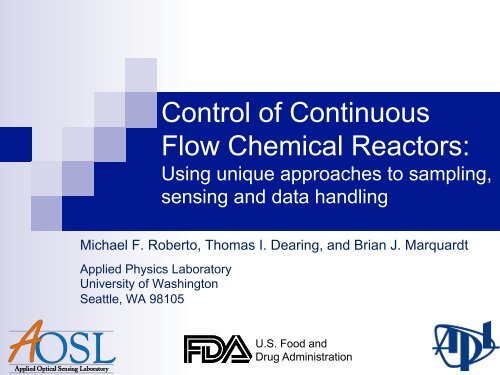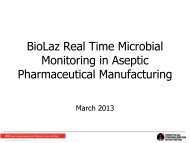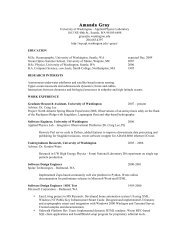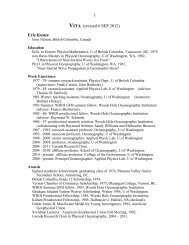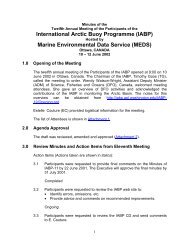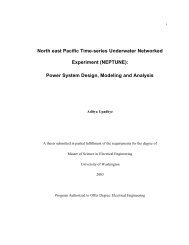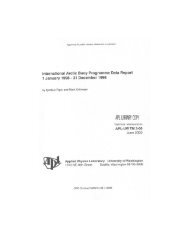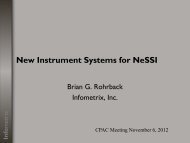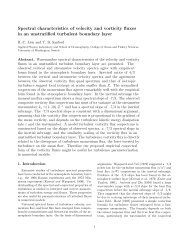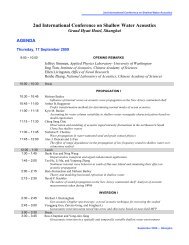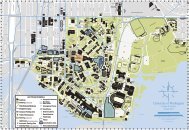Control of Continuous Flow Chemical Reactors: - CPAC - University ...
Control of Continuous Flow Chemical Reactors: - CPAC - University ...
Control of Continuous Flow Chemical Reactors: - CPAC - University ...
- No tags were found...
Create successful ePaper yourself
Turn your PDF publications into a flip-book with our unique Google optimized e-Paper software.
<strong>Control</strong> <strong>of</strong> <strong>Continuous</strong><strong>Flow</strong> <strong>Chemical</strong> <strong>Reactors</strong>:Using unique approaches to sampling,sensing and data handlingMichael F. Roberto, Thomas I. Dearing, and Brian J. MarquardtApplied Physics Laboratory<strong>University</strong> <strong>of</strong> WashingtonSeattle, WA 98105U.S. Food andDrug Administration
<strong>Continuous</strong> <strong>Flow</strong> Chemistry - Approachn Design and develop CF reactor system that includessmart sampling and real-time analytics for thepurpose <strong>of</strong> quickly and efficiently developing,optimizing and controlling new chemistriesn Focus on taking a “systems approach” to developingand controlling chemistry in continuous flow¨ Define analytical tools – information, speed and cost¨ Define smart sampling and control – smart valves, flowcomponents, reactors, temperature control,….¨ S<strong>of</strong>tware and hardware interfaces for automated control <strong>of</strong>chemical process/systemn Development – automated design <strong>of</strong> experimentsn Production – feedback or feed forward control models for QA/QC2
Analytical <strong>Control</strong> System DesignOptimizationFeedback& <strong>Control</strong>ProcessModelingData FusionAnalytics and Data HandlingHardware <strong>Control</strong> and Monitoring(S<strong>of</strong>tware)Hardware – NeSSI, Raman,Other PAT, Reactor
Reactor Hardware and Analyticsn Corning CF Reactorn Kaiser 4-channelRaman systemn Mettler Toledo IRn On-line analytics¨ Pressure¨ Temperature¨ <strong>Flow</strong>n NeSSI SamplingSystem
Sampling Systems• NeSSI Components• Industry-driven effort todefine and promote a newstandardized alternative tosample conditioning systemsfor analyzers and sensors Standard fluidic interface formodular surface-mountcomponentsISA SP76 Standard wiring andcommunications interfaces Standard platform formicro analytics
What does NeSSI Providen Simple “Lego-like” assembly¨ Easy to re-configure¨ No special tools or skills requiredn Standardized flow components¨ “Mix-and-match” compatibility between vendors¨ Growing list <strong>of</strong> componentsn Standardized electrical and communication (Gen II)¨ “Plug-and-play” integration <strong>of</strong> multiple devices¨ Simplified interface for programmatic I/O and controln Advanced analytics (Gen III)¨ Micro-analyzers¨ Integrated analysis or “smart” systems
NeSSI Sampling System for ReactorRaman Probemonitorcleanbypass
System <strong>Control</strong> and AnalyticsHPLC Pump(<strong>Flow</strong> Rate)Back PressureRegulator<strong>Flow</strong> MeterPressureGaugeThermocouple Raman Other PAT<strong>Control</strong>Analytics• Reactant 1HPLC Pump(<strong>Flow</strong> Rate)Back PressureRegulator<strong>Flow</strong> MeterPressureGaugeThermocouple Raman Other PAT• Reactant 2Temperature<strong>Control</strong><strong>Flow</strong> MeterPressureGaugeThermocoupleRaman Other PAT Needle Valve• Product
NeSSI Reagent Sampling SystemNeSSI Product Sampling Sys.
Reaction Procedure and Setupn Chemistry performed in reactorn On-line Raman monitoring onend <strong>of</strong> product linen Each variable independentlycontrolled in DoE to enableunderstanding <strong>of</strong> each criticalprocess parameter¨ Computer control <strong>of</strong> flow andtemperature¨ Catalyst concentration controlledmanually10
Corning ® Advanced-<strong>Flow</strong> TM LFLow-<strong>Flow</strong> Capability (1-10 mL/min)Corning has introduced a reducedflow-rate reactor that retains theoutstanding mixing and heatexchange performance <strong>of</strong> itsAdvance-<strong>Flow</strong> TM glass reactorswhile providing:§ Low internal volume (2 mL flow)§ High flexibility§ Metal-free reaction path§ Scalability§ Compatibility with analytics§ T, <strong>Flow</strong> and Pumping control
NeSSI Raman BallprobeBallprobe Specs.• Hastelloy C-276Ti, SS, Monel• Sapphire optic• Std. temp range:-80 > 400° C• Pressure:0-350 Bar12Matrix Solutions: www.ballprobe.com
Full Reactor System w/<strong>Control</strong>2.5 ft
Initial System Demonstration<strong>Control</strong> <strong>of</strong> Esterification14
<strong>Chemical</strong> Reactionn Esterification <strong>of</strong> benzoic acidn Straight-forward, pharmaceutically relevantn Strong dependence on temperature, flow ratesWiles, C., Watts, P. 2009
Temperature vs. Reaction Progressn Clear correlationbetween temperatureand product formationn Reaction progress notlinearly correlatedwith temperature¨ Expected for thisreactionn Similar results whenflow and catalystconcentration varyTemperature (C)Raman PC1 Scores (AU)16015014013012011010090807060Temperature (C)Raman PC1 Scores60° C 100° C 140° C0 20 40 60 80 100 120 140 160Time (min)
Temperature vs. Reaction Progress
<strong>Flow</strong> Rate vs. Reaction Progressn Slower flow rate(longer residencetime) correlated withhigher yieldn Too slow results inunsteady yield frominefficient mixing(outside reactorspecifications)Scores on PC 1 (64.43%)Samples/Scores Plot <strong>of</strong> Raman Data320.2 mL/min8 mL/min4 mL/min 2 mL/min 1 mL/min 0.5 mL/min10-1-2-350 100 150 200 250 300 3504 x 104 Samplen Boundaries defined:8 mL/min & 1 mL/min18
Catalyst Conc. Vs. Reaction Progressn Correlation betweenconcentration andyield <strong>of</strong> productn Little variation in yieldbelow 0.275Mn 2.2M solution resultedin significant increasein yield, but wasabove reactorspecifications19
Reaction Monitoring with Ramann Spectrum cropped toregion <strong>of</strong> interestbelow, with a 1 st orderpolyfit appliedn Standards <strong>of</strong>0% to 100%productn Responsivein RamanRaman Signal (A.U.)54.543.532.521.510.5x 10 4Raman Signal (A.U.)120001000080006000400020000ProductReagent720 740 760 780 800 820 840 860Raman Shift (cm^-^1)0400 600 800 1000 1200 1400 1600 1800Raman Shift (cm^-^1)
PLS Raman Validation ModelYield Predicted by Raman (%)100908070605040PLS Model - Raman Yield Prediction vs. HPLCHigh Catalyst ConcentrationR 2 = 0.9992 Latent VariablesRMSEC = 0.91141RMSEP = 2.1617Calibration Bias = 0Prediction Bias = 0High T, Low R tHigh T, High R t30Y Predicted 120CalibrationTest10Low T, High R t1:10Low T, Low R tfit0 20 40 60 80 100Yield Measured by HPLC (%)
Real-Time Process Understandingn Real-Time monitoring requires new s<strong>of</strong>twaredeployment:¨ Integration <strong>of</strong> fast on-line spectroscopy¨ <strong>Chemical</strong> yield information must be within controls<strong>of</strong>twaren Design towards future control implementations¨ Maintain continuous monitoringn Early warning signs for process upsetsn Continuity in modeling univariate parametersn Rapid analysis allows for timely decision making¨ Typical Raman analysis time = 20 seconds22
Real-Time Quantitative Yieldn Able to monitorreaction throughthree designpoints (flow rates)n Identify whensystem isequilibrated1 mL/min2 mL/min4 mL/minManuscript in Preparation23
100PLS Model - Raman Yield Prediction vs. HPLCReal-Time Quantitative AnalysisYield Predicted by Raman (%)908070605040302010Validation <strong>of</strong> Real-Time Yield Model00 20 40 60 80 100Yield Measured by HPLC (%)1 mL/min2 mL/min4 mL/minManuscript in Preparation24
Real-Time Quantitative Analysisn Rapid online quantitative real-time analysisconclusively demonstrated with Ramanspectroscopy¨ 20 s from start <strong>of</strong> spectrum acquisition to chemicalconversion informationn Less than 1 second to model spectrumn ~19 seconds Raman spectral acquisition¨ <strong>Continuous</strong> information output with no moving parts,operators, or supplies25
Current Studiesn Expand Chemistry¨ Working with an industrial collaborator to optimize anew, multistep pharmaceutical reaction for continuousproduction¨ Investigating continuous solvent exchangen Automated design <strong>of</strong> experiments¨ Automate generation <strong>of</strong> response surfaces¨ Derive reaction kinetics from spectroscopy¨ Produce generic optimization and control strategyn Implement modeling control strategy through theuse <strong>of</strong> PID control theory26
M<strong>of</strong>fat Swern Oxidation <strong>of</strong> Alcoholn Cryogenic reaction requires -70°C in batch¨ Very exothermic, with unstable intermediatesn M<strong>of</strong>fat Swern oxidation has been performed incontinuous microliter scale previously¨ All chemistry analyzed <strong>of</strong>fline – no controln Low-temperature reaction in batch, can beperformed at up to room temperature in CFRn 4 feeds in 3 reactors - preparation <strong>of</strong> oxidizingagent, oxidation, quench
M<strong>of</strong>fat Swern Oxidation <strong>of</strong> Alcohol28
Experimental Batch - Developmentn Reactants were precooledusing Corningreactor plate to -20°Cn <strong>Continuous</strong> addition toensure low tempn Maintaining -70°C bathrequired regular dry iceadditionn Vessel included 3 probesplus port for addition <strong>of</strong>chemicals29
Infrared Observationsn Collection timecompared to Raman¨ 4 Raman spectra forevery 1 IR collectionn Temperature exhibitsa large role in thevariation <strong>of</strong> spectra¨ Preprocessing appliedto spectra to reducethis effectn EMSCSignal Intensity10.80.60.40.201800Raw IR Data1600 1400 1200 1000- 1Wavenumber cm800n Baseline correction
IR Reaction Progressn Reaction progress:start to finishn Clear change spectralpr<strong>of</strong>ile as reactionprogresses¨ Formation <strong>of</strong> peak at1680 wavenumbers¨ Generation <strong>of</strong>intermediate at 1750
3D Representation <strong>of</strong> IR Data0.30.2Intensity0.10-0.11900180017004060801001600Wavenumber cm -11500020TimeSame region in 3D time-space, shows generation <strong>of</strong> intermediate
Infrared Conclusionsn Spectral changes apparent¨ Clear intermediate formationn Separating rate <strong>of</strong> formation <strong>of</strong> product (whichoccurs during warming <strong>of</strong> reactor) is difficultn Data fusion with Raman spectra (up next) maygive improved resultsn Will not be an issue in continuous flow¨ All acquisitions will be at the same temperatureallowing for direct comparisons33
Raman setup and settingsnRaman¨ 785nm Excitation wavelength¨ Raman 1/8” ball probe¨ 1 s Exposure time, 5 acquisitionsx 10 4108Intensity6420500 1000 1500Raman Shift (cm-1)
Pre-processed Raman Data7000Reaction progress: start to finish60005000Intensity40003000200010000800 900 1000 1100 1200 1300 1400 1500 1600 1700Raman Shift (cm-1)
Region 1560-1720 cm -1 (blue region)SelectivePeak forintermediateSelectivepeaks forProduct
Raman Reaction PlotRAMAN SCORE PLOT (region 1560 to 1720 cm -1 ) and reaction temerature8000406000Score PC1 81.69% (Product)Score PC2 18.07 % (Intermediate)Temperature20Scores400020000Product starts forming quicly whentemperature reaches about -50 CIntermediate formedas Alcohol is added0-20-40Temperature (C)-2000-60TFAA additionDMSO additionAlcohol additionTEA addition-40000 10 20 30 40 50 60 70 80 -80Time (min)
Raman Validated Against HPLC8000RAMAN SCORE PLOT(region 1560 to 1720 cm -1 )and HPLC reference data10090600080Scores40002000PC1PC2AlcoholProductIntermediate7060504030HPLC determined Yield (%)02010-200060 65 70 75 80 0Time (min)
Concluding Remarks onSpectroscopic AnalysisnnnnInfrared shows much promise – CF and Data Fusion¨ More heavily impacted by temperature variation¨ Further work needed to separate temperature effectsnIn continuous flow, this will not be an issue.Raman is very promising for quantitative measurement <strong>of</strong> productionyield in batch¨ Good selective regions¨ No fluorescence¨ Minimally affected by temperature¨ Capable <strong>of</strong> monitoring side productsRaman will work well in a continuous setup¨ Multiple probes, multiplexing and very informativeSuccess <strong>of</strong> PCA modeling <strong>of</strong> spectral data indicates that HPLC willbe required only for model construction and periodic maintenance39
Further Workn PLS Calibration Model¨ Quantitative informationn Data Fusion¨ Both infrared and Ramanshown to be viable in batch¨ Further analysis <strong>of</strong> IR –separate temperatureeffects¨ Addition <strong>of</strong> T, P, RI andflow to fusion modelsn Complete the new reactorsystem build40
Swern Reactor w/sampling + Analytics41
Sampling System and Analytics42
Data Fusionn There is no one perfect process analyzer that canmeasure all samples, in all states under any conditionn Concept:Surround a chemical problem or process withcomplimentary and orthogonal tools to extract a greaterquantity <strong>of</strong> information than each tool individually providesn In most cases the complimentary and orthogonalmeasurements are already collected throughout aproduction cyclen Use <strong>of</strong> data fusion can increase the informationextracted from these measurements and thereforeincrease the value <strong>of</strong> the measurement
Data Fusion ProcedureIRSCALEDIRSCALENMRSCALEDNMRSCALERAMANRAMANPOLYFIT +SCALEPOLYFIT +SCALEIRNMRRAMANFUSED DATADearing, T.; Thompson, W.; Rechsteiner, C.; Marquardt, B.; J. Applied Spectroscopy, February 2011, Volume 65, Issue 2, pp. 181-186.
ResultsComparison <strong>of</strong> Individual Models to Fused ModelRSEP /%76543210API Weight % H2Raman IR NMR FusedQuantity Raman IR NMR Fused°API 1.96% 1.85% 0.477% 0.237%Weight % 2.50% 6.36% 0.844% 0.451%H 2 Content 0.708% 0.463% 0.063% 0.03%
Acknowledgementsn Marquardt Groupn Applied Physics Lab – Univ. <strong>of</strong> Washingtonn Center for Process Analysis and <strong>Control</strong> (<strong>CPAC</strong>)n FDA, ORISEn Parkern Kaiser Optical Systemsn Mettler-Toledon Corning


